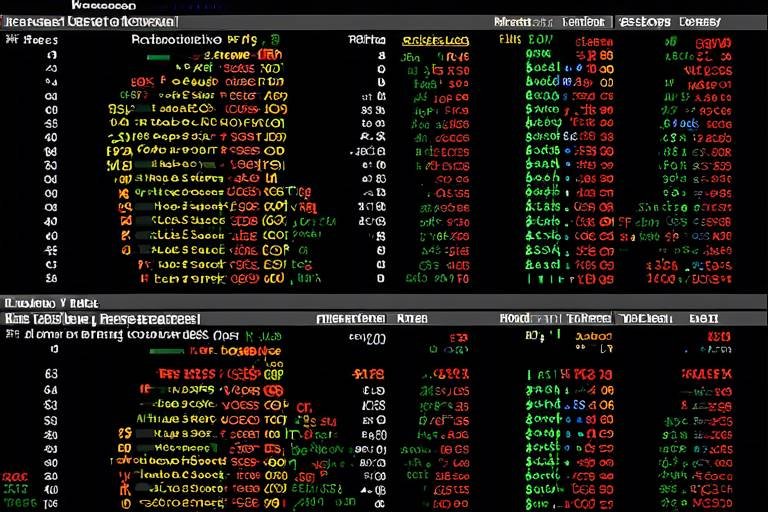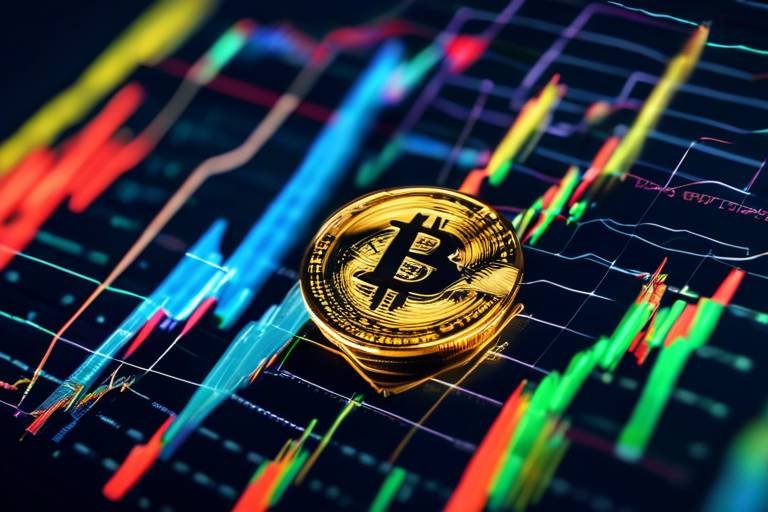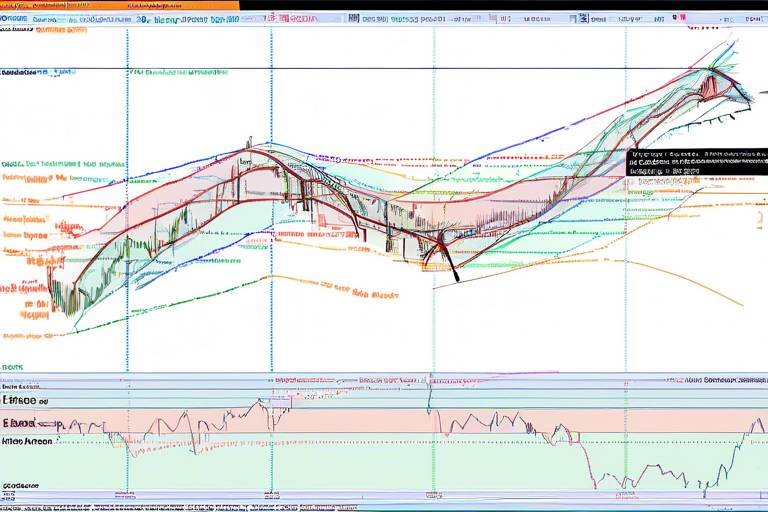The Impact of Seasonal Trends on Cryptocurrency Prices
In the dynamic world of cryptocurrency, prices are influenced by a myriad of factors, but one that often flies under the radar is the impact of seasonal trends. Just as the changing seasons affect our moods and behaviors, they also shape the landscape of the crypto market. Understanding these seasonal trends can be the key to unlocking profitable investment opportunities. In this article, we will delve deep into how these seasonal patterns manifest, drawing on historical data and market psychology to equip you with the knowledge to navigate the volatile waters of cryptocurrency trading.
Seasonal trends refer to predictable patterns in market behavior that occur at specific times of the year. Just like how retail businesses see spikes during the holiday season, cryptocurrencies tend to experience fluctuations tied to various seasonal factors. For investors, recognizing these trends is crucial; it’s akin to having a roadmap that guides you through the often-turbulent journey of cryptocurrency investments. By identifying these patterns, you can make informed decisions that align with market cycles, ultimately enhancing your chances of success.
When we examine historical price data, a fascinating picture emerges. Cryptocurrencies often show recurring patterns during certain seasons. For instance, many investors have observed that winter months tend to bring about significant price increases, often referred to as "bull runs." This correlation between winter and bullish trends is not merely coincidental; it reflects a complex interplay of market sentiments, investor behaviors, and external events. Analyzing these trends can provide invaluable insights into potential future market movements, helping investors anticipate where prices might head next.
Historically, many cryptocurrencies experience significant price increases during winter months. But why does this happen? One reason could be the psychological boost that comes with the holiday season. As people reflect on their financial goals for the upcoming year, they may be more inclined to invest in cryptocurrencies. This seasonal optimism often translates into increased buying activity, driving prices higher. Additionally, the winter months are typically associated with major events, such as New Year's resolutions and year-end financial planning, which can further fuel market activity.
Investor sentiment tends to shift in winter, often leading to increased buying activity. As the weather turns colder, many people are indoors, perhaps spending more time on their devices and engaging with the crypto community. This increased engagement can lead to heightened interest in buying and trading. Understanding this sentiment can help investors capitalize on seasonal trends. It’s essential to tune into the market's emotional pulse during these months, as it can significantly influence price movements.
Key events, such as holidays and year-end financial planning, can impact trading volumes and prices. For instance, the festive season often sees a surge in investment as people look to capitalize on the market’s upward momentum. Additionally, many investors reassess their portfolios at the end of the year, which can lead to strategic buying or selling. This subsection examines how these events shape market dynamics, emphasizing the importance of being aware of the calendar when making investment decisions.
Conversely, summer months often see a slowdown in trading activity and price stagnation. This phenomenon, sometimes referred to as the "summer doldrums," can be attributed to several factors. People typically take vacations during the summer, leading to decreased market participation. Moreover, the warmer months can bring about a sense of complacency among investors, resulting in less trading activity overall. Understanding these factors can help investors prepare for potential dips in market activity during this period.
Market psychology plays a crucial role in seasonal price movements. Just as the weather can affect our mood, the sentiment of investors can significantly influence market behavior. Understanding how investor behavior changes with the seasons can enhance trading strategies. For example, during bullish periods, investors may be more inclined to take risks, while during bearish periods, fear may lead to conservative trading. Recognizing these psychological shifts is essential for navigating the crypto landscape effectively.
The Fear and Greed Index reflects market sentiment and can influence trading decisions. When investors are feeling greedy, they may rush to buy, pushing prices up. Conversely, during periods of fear, they may panic sell, driving prices down. Analyzing this index during different seasons can provide valuable insights for investors looking to time their trades effectively. It’s a powerful tool that can help you gauge the market’s emotional state, allowing you to make more informed decisions.
Implementing investment strategies that align with seasonal trends can improve profitability. For example, savvy investors may choose to increase their holdings during winter months when prices are likely to rise. On the other hand, during the summer doldrums, they might consider taking profits or reallocating their investments. This section offers practical tips for traders looking to leverage seasonal patterns in the cryptocurrency market, emphasizing the importance of adaptability and foresight.
- What are seasonal trends in cryptocurrency? Seasonal trends are predictable patterns in market behavior that occur at specific times of the year, influencing cryptocurrency prices.
- How can I identify seasonal trends? Analyzing historical price data and market sentiment can help identify seasonal trends in the cryptocurrency market.
- Why do cryptocurrencies perform better in winter? Factors such as increased investor sentiment, holiday spending, and year-end financial planning contribute to bullish trends during winter.
- What is the Fear and Greed Index? The Fear and Greed Index measures market sentiment, indicating whether investors are feeling fearful or greedy, which can influence trading decisions.

Understanding Seasonal Trends
Seasonal trends are fascinating phenomena that can significantly influence cryptocurrency prices. Essentially, these trends represent predictable patterns in market behavior that recur at specific times throughout the year. Just like how the seasons affect our mood and activities, they also have a profound effect on how investors approach the crypto market. Understanding these seasonal trends can be a game-changer for anyone looking to navigate the often-turbulent waters of cryptocurrency investment.
Think of it this way: just as certain retail sectors experience spikes in sales during the holiday season, cryptocurrencies can also see fluctuations in their valuations based on the time of year. For instance, many investors often experience a sense of optimism during the winter months, which can lead to increased buying activity. Conversely, summer months may bring about a sense of lethargy in the market, causing prices to stagnate or even decline.
To grasp the full impact of seasonal trends, it’s crucial to consider various factors that contribute to these patterns. Some of these factors include:
- Market Sentiment: The emotions and attitudes of investors can shift dramatically with the seasons, often leading to increased buying or selling pressure.
- Economic Events: Certain events, such as tax season or holiday shopping, can either boost or dampen trading activity.
- Historical Data: Analyzing past price movements during specific seasons can provide valuable insights into potential future trends.
By recognizing these seasonal trends, investors can make more informed decisions about when to enter or exit the market. It’s like having a weather forecast for your investments; you wouldn’t go sailing in a storm, so why would you dive into a market without understanding its seasonal patterns? The key takeaway here is that being aware of these trends allows investors to strategize effectively, potentially maximizing their returns while minimizing risks.
Moreover, understanding seasonal trends isn't just about recognizing patterns; it’s about anticipating how these patterns will influence market behavior. For instance, if historical data suggests that a particular cryptocurrency tends to perform well in the winter, savvy investors can prepare to capitalize on that trend. They might increase their holdings or adjust their trading strategies to align with the expected price movements.
In summary, understanding seasonal trends is essential for anyone serious about investing in cryptocurrencies. By paying attention to market sentiment, economic events, and historical data, investors can navigate the crypto landscape with greater confidence and insight. So, gear up and keep an eye on those seasonal shifts; they could very well dictate your investment success!

Historical Price Patterns
When we dive into the world of cryptocurrency, one of the most fascinating aspects is the that emerge over time. By analyzing past data, we can uncover trends that inform our understanding of what might happen next. Think of it like reading the weather forecast; while it’s not always 100% accurate, it gives you a good idea of what to expect based on historical data. In the crypto market, these patterns often reveal recurring cycles that can help investors make informed decisions.
For instance, if we look back over the last several years, we see a clear trend where certain cryptocurrencies, like Bitcoin and Ethereum, tend to experience price surges during winter months. This phenomenon often aligns with the end-of-year financial activities, such as holiday shopping and year-end bonuses. To illustrate, let’s take a look at the following table that summarizes the average price movements of Bitcoin during the winter months over the past five years:
| Year | Average Price in December | Average Price in January | Price Change (%) |
|---|---|---|---|
| 2018 | $3,800 | $3,600 | -5.26% |
| 2019 | $7,200 | $8,800 | 22.22% |
| 2020 | $19,100 | $29,000 | 51.88% |
| 2021 | $47,000 | $33,000 | -29.79% |
| 2022 | $16,500 | $23,000 | 39.39% |
This table highlights not just the prices but also the price changes from December to January, showcasing the volatility that can occur during this season. As you can see, while 2021 presented a significant drop, other years like 2019 and 2022 showcased substantial gains. This volatility is a key characteristic of the crypto market, making it crucial for investors to stay informed about these historical price patterns.
Moreover, it's essential to consider that these historical price movements are not just random occurrences. They are often influenced by a combination of factors, including market sentiment, investor behavior, and external events such as regulatory news or technological advancements. For example, during periods of economic uncertainty, investors may flock to cryptocurrencies as a hedge against inflation, further driving up prices.
By recognizing these historical patterns, investors can develop strategies that align with seasonal trends, potentially enhancing their profitability. It's like having a roadmap; knowing where the bumps in the road are can help you navigate more smoothly. So, the next time you’re considering making a move in the crypto market, take a moment to reflect on the historical price patterns that might be at play. They could very well guide your decisions and lead to successful outcomes.

Winter and Bull Runs
When it comes to the cryptocurrency market, winter is not just a season; it's a phenomenon that often ushers in a wave of bullish activity. Historically, many cryptocurrencies, including giants like Bitcoin and Ethereum, have shown significant price increases during the colder months. But why does this happen? Well, it’s a combination of market sentiment, seasonal behaviors, and even cultural factors that come into play.
One of the primary reasons winter tends to correlate with bullish trends is the change in investor sentiment. As the year draws to a close, many investors reflect on their financial goals and performance. This introspection often leads to increased buying activity as people look to maximize their portfolios before the new year. The holiday season also plays a significant role; with many individuals receiving bonuses or gifts, there’s often more disposable income available for investment. This influx of cash can create a surge in buying pressure, driving prices up.
Moreover, the winter months are often characterized by a sense of optimism. The festive spirit, coupled with year-end financial planning, can lead to a bullish outlook among investors. It’s as if the cold weather brings warmth to the market, igniting a spark of enthusiasm. This seasonal optimism is further amplified by major events like New Year's resolutions, where many people resolve to invest more seriously in cryptocurrencies. This creates a feedback loop where rising prices attract more attention, leading to even higher prices.
Additionally, key events during the winter can significantly impact trading volumes and prices. For instance, the holiday season often sees a spike in trading activity as people buy cryptocurrencies as gifts or invest in them as part of their financial planning. The end of the year also brings significant events like tax-loss harvesting, where investors sell off losing assets to offset gains, creating a unique dynamic that can influence market behavior.
To illustrate this phenomenon, let’s take a look at a table that summarizes the price movements of Bitcoin over the past few winter seasons:
| Year | December Price | January Price | Percentage Increase |
|---|---|---|---|
| 2020 | $29,000 | $41,000 | 41.4% |
| 2021 | $46,000 | $60,000 | 30.4% |
| 2022 | $47,000 | $38,000 | -19.1% |
As you can see, while not every winter guarantees a bull run, the patterns suggest a higher likelihood of price increases during this season. Understanding these trends can empower investors to make informed decisions and capitalize on the seasonal dynamics of the crypto market.
In conclusion, winter is more than just a season for cryptocurrencies; it’s a time of opportunity. By recognizing the psychological and market-driven factors that contribute to bullish trends, investors can position themselves strategically to benefit from these seasonal fluctuations. So, as the temperatures drop, keep an eye on the crypto market; it might just be the perfect time to warm up your portfolio!

Market Sentiment in Winter
The winter months are often a fascinating time in the cryptocurrency world, where market sentiment can shift dramatically. As the air turns crisp and the holiday season approaches, many investors find themselves more optimistic about their portfolios. This change in attitude can be attributed to several factors, including the festive spirit, year-end financial planning, and the natural inclination to reflect on the year gone by. During this period, many traders are more likely to engage in buying activities, driven by the hope of capitalizing on potential price increases.
One of the most compelling aspects of winter is how it fosters a sense of community among investors. The holiday season often brings people together, leading to increased discussions about investments, strategies, and market trends. This communal atmosphere can create a positive feedback loop, where rising prices attract even more buyers, further pushing prices up. It's almost as if the market becomes a snowball, gathering momentum as it rolls downhill, fueled by collective enthusiasm.
Moreover, the winter months often coincide with major financial events such as tax-loss harvesting and year-end bonuses. Investors might sell off underperforming assets to offset gains, but they also tend to reinvest those funds into promising cryptocurrencies. This phenomenon can lead to increased trading volumes and price surges. For instance, many traders anticipate the influx of new capital during this time, which can lead to a bullish sentiment across various cryptocurrencies.
It's important to note that while winter generally brings about positive market sentiment, it’s not without its challenges. The emotional nature of investing can lead to overenthusiasm, where traders might jump into investments without proper analysis. This could result in volatility, as prices may rise too quickly and then correct sharply. Therefore, understanding the psychology behind winter trading is crucial for any investor looking to navigate the crypto landscape effectively.
In summary, the winter months present a unique opportunity for investors. The combination of seasonal sentiment, community engagement, and strategic financial planning can create a fertile environment for price increases. However, it’s essential to remain cautious and informed, as the emotional highs of winter trading can lead to unexpected market fluctuations.

Major Events in Winter
Winter is more than just a season of cold; it’s a time when the cryptocurrency market often experiences notable shifts due to various major events that take place during this period. From holiday spending to year-end financial strategies, these events can significantly impact trading volumes and, consequently, prices. For instance, as the holiday season approaches, many investors may find themselves more willing to invest in cryptocurrencies, driven by the festive spirit and the desire to capitalize on potential gains before the year ends.
One of the most significant factors during winter is the holiday shopping season. Many individuals and businesses allocate budgets for gifts, and some of this money may find its way into cryptocurrencies. This influx of cash can create a bullish effect, pushing prices higher as demand increases. Furthermore, with many people receiving bonuses or extra income during the holiday season, there's often a sense of optimism that can drive investment decisions.
Another critical event is the New Year’s resolution phenomenon. As the calendar flips, people often set new financial goals, including investing in cryptocurrencies. This can lead to a surge in interest and investment as individuals look to diversify their portfolios or enter the crypto market for the first time. The psychological effect of a new year can be powerful, encouraging a fresh start and a willingness to take risks.
Moreover, year-end financial planning plays a crucial role. Investors frequently reassess their portfolios as the year comes to a close, aiming to maximize their tax benefits. Some may choose to sell off underperforming assets while reallocating funds into cryptocurrencies that they believe will perform better in the upcoming year. This strategic maneuvering can lead to increased trading activity and price fluctuations as investors react to their assessments.
To illustrate the impact of these events, consider the following table that summarizes the potential effects of major winter events on cryptocurrency prices:
| Event | Potential Impact on Cryptocurrency Prices |
|---|---|
| Holiday Shopping Season | Increased demand leading to price surges |
| New Year’s Resolutions | Heightened interest and new investments |
| Year-End Financial Planning | Increased trading activity and potential price volatility |
In conclusion, the winter season is not just a time for snow and festivities; it’s a period ripe with opportunities for cryptocurrency investors. By understanding the dynamics of major events during this time, investors can better position themselves to take advantage of the seasonal trends that often unfold. Whether it’s riding the wave of holiday spending or capitalizing on year-end financial strategies, recognizing these patterns can lead to more informed and potentially profitable investment decisions.

Summer Doldrums
Ah, summer! A season that brings sunshine, vacations, and, unfortunately for cryptocurrency enthusiasts, a phenomenon often referred to as the . During these warmer months, the cryptocurrency market tends to experience a notable slowdown. But why does this happen? Understanding the factors behind this seasonal dip can help investors strategize effectively and perhaps even seize opportunities when others are sitting idle.
One significant reason for the summer slump is the shift in investor focus. As the weather warms up, many traders and investors take time off for vacations or outdoor activities. This decrease in active participation can lead to lower trading volumes, resulting in less market momentum. When fewer people are trading, price movements become less volatile, often leading to stagnation. Think of it like a party: if half the guests leave, the energy in the room drops significantly!
Moreover, summer often coincides with a general lack of major market catalysts. Unlike the winter months, which are packed with events like holidays and year-end financial planning, summer lacks significant news that can drive prices upward. Without these catalysts, traders may feel less inclined to make moves, leading to a consolidation phase where prices hover around the same levels for extended periods. This can be frustrating for those looking for quick gains.
Additionally, seasonal trends in traditional markets can also affect cryptocurrency prices. Many investors diversify their portfolios during the summer, moving funds into stocks or other assets that may offer better returns during this period. This shift can further contribute to the lack of enthusiasm in the crypto market, as funds that might have flowed into cryptocurrencies are instead diverted elsewhere.
Interestingly, some analysts have noted that while the summer months are often characterized by stagnation, they can also serve as a valuable period for accumulation. Savvy investors who recognize the seasonal trend can use this time to buy cryptocurrencies at lower prices, positioning themselves for potential gains when the market inevitably heats up again in the fall. So, while summer may feel like a lull, it can also be a golden opportunity for those who are willing to take a contrarian approach.
In summary, the summer doldrums in the cryptocurrency market can be attributed to a combination of decreased investor activity, a lack of major market events, and shifts in investment focus. However, for those who understand these patterns, summer can also be a time of strategic accumulation. As the saying goes, "When others are fearful, be greedy." So, while the sun is shining and the market may be quiet, keep your eyes peeled for those hidden gems!
- What are the Summer Doldrums in cryptocurrency?
The Summer Doldrums refer to a period during the summer months when trading activity and price movements in the cryptocurrency market typically slow down.
- Why does trading volume decrease in summer?
Many investors take vacations or shift their focus to other investments during the summer, leading to decreased participation in the crypto market.
- Can summer be a good time to buy cryptocurrencies?
Yes! The summer slump can present opportunities for savvy investors to purchase cryptocurrencies at lower prices before market activity picks up again in the fall.

Psychological Factors
When it comes to cryptocurrency trading, understanding is as crucial as analyzing the numbers. The crypto market is not just a cold, hard financial arena; it's a vibrant ecosystem influenced by human emotions, perceptions, and behaviors. This is where the Fear and Greed Index comes into play, acting as a barometer of market sentiment. Have you ever noticed how your mood can sway your financial decisions? Well, the same principle applies to thousands of investors worldwide, making sentiment analysis a powerful tool in predicting market movements.
During periods of extreme fear, investors tend to panic, often leading to sell-offs and price drops. Conversely, when greed takes over, prices can skyrocket as people rush to buy in hopes of riding the next wave of gains. This cyclical dance of fear and greed creates a rollercoaster effect in the market. For instance, during winter months, as the excitement builds around holiday spending and year-end bonuses, many investors feel more optimistic, leading to increased buying activity. In contrast, the summer months may bring a sense of lethargy, causing many to step back and reassess their strategies, which can lead to stagnation in trading volumes.
To further illustrate this point, let’s take a look at how the Fear and Greed Index fluctuates throughout the year:
| Season | Fear and Greed Index | Market Sentiment |
|---|---|---|
| Winter | 70-90 | Greed |
| Spring | 50-70 | Neutral to Greed |
| Summer | 30-50 | Fear |
| Autumn | 40-60 | Neutral |
This table highlights the shifting sentiments throughout the year, giving investors a clearer picture of when to enter or exit the market. But remember, while the Fear and Greed Index is a useful tool, it should not be the sole basis for your trading decisions. Market psychology is complex and can be influenced by a myriad of factors, including news events, regulatory changes, and even social media trends.
To successfully navigate these psychological waters, traders must develop a keen sense of self-awareness. Are you acting out of fear? Or are you letting greed cloud your judgment? Recognizing your emotional triggers can be a game-changer. Consider keeping a trading journal where you document not just your trades but also your feelings and thoughts at the time. This practice can help you identify patterns in your behavior and adjust your strategies accordingly.
Ultimately, understanding psychological factors in the cryptocurrency market can enhance your trading strategies. By blending market analysis with a deep understanding of human behavior, you can position yourself to take advantage of seasonal trends and investor sentiment shifts. So, the next time you check your portfolio, take a moment to reflect on not just the numbers but also the emotions driving them. Are you ready to make your next move?
- What is the Fear and Greed Index?
The Fear and Greed Index is a measure of market sentiment that gauges the emotions driving investor behavior, ranging from extreme fear to extreme greed.
- How do seasonal trends affect cryptocurrency prices?
Seasonal trends can lead to predictable patterns in buying and selling activity, influencing price movements based on historical data and market psychology.
- Why is understanding market psychology important?
Understanding market psychology helps investors anticipate price movements and make informed trading decisions based on emotional triggers rather than just data.

Fear and Greed Index
The is a powerful tool that gauges market sentiment, providing investors with a clear snapshot of whether the market is feeling fearful or greedy. This index operates on the premise that extreme fear can lead to poor decision-making, often resulting in missed opportunities, while extreme greed can create bubbles that may eventually burst. By understanding where the market stands on this emotional spectrum, traders can make more informed decisions about when to buy or sell their cryptocurrencies.
Typically, the Fear and Greed Index is calculated using various factors, including volatility, market momentum, social media sentiment, and surveys. Each of these elements contributes to a score that ranges from 0 to 100, where:
| Score Range | Market Sentiment |
|---|---|
| 0-24 | Extreme Fear |
| 25-49 | Fear |
| 50 | Neutral |
| 51-74 | Greed |
| 75-100 | Extreme Greed |
During the winter months, when many investors are feeling optimistic about the market, the Fear and Greed Index often trends towards the higher end of the scale. This bullish sentiment can lead to increased buying activity, driving prices up. Conversely, during the summer doldrums, the index may reflect a more fearful sentiment, resulting in stagnation or even declines in cryptocurrency prices.
Understanding the Fear and Greed Index is essential for traders who want to align their strategies with market psychology. For instance, when the index indicates extreme fear, it might be a prime opportunity to buy, as prices may be undervalued. On the other hand, when greed takes over, it could be a signal to take profits or even short-sell, anticipating a market correction.
In summary, the Fear and Greed Index serves as a crucial barometer for investors navigating the often tumultuous waters of the cryptocurrency market. By paying attention to this index, traders can harness the emotional currents that drive market behavior, ultimately positioning themselves for greater success.
- What is the Fear and Greed Index? The Fear and Greed Index is a measure of market sentiment in the cryptocurrency market, indicating whether investors are feeling fearful or greedy.
- How is the Fear and Greed Index calculated? It is calculated using various factors, including volatility, market momentum, social media sentiment, and surveys.
- Why is the Fear and Greed Index important? Understanding this index helps investors make informed decisions about when to buy or sell based on market sentiment.
- How can I use the Fear and Greed Index in my trading strategy? Traders can use the index to identify potential buying or selling opportunities based on market emotions.

Seasonal Investment Strategies
Investing in cryptocurrencies can often feel like navigating a roller coaster, with its ups and downs influenced by a myriad of factors. However, by understanding and leveraging seasonal trends, investors can enhance their strategies and potentially increase their returns. So, how can you align your investment approach with these seasonal patterns? Let’s dive in!
First off, it’s essential to recognize the distinct phases of the market throughout the year. For example, many investors find that the winter months are particularly favorable for buying. This is often due to the holiday season, where people are more inclined to invest as they look forward to the new year. In contrast, the summer months can be characterized by lower trading volumes and price stagnation. Therefore, having a strategy that accounts for these fluctuations can be incredibly beneficial.
One effective strategy is to adopt a buy-and-hold approach during the winter months. This means purchasing cryptocurrencies when prices are low and holding onto them until the market heats up, typically around spring. This strategy capitalizes on the bullish sentiment that often emerges during winter. However, it’s important to keep an eye on market sentiment and adjust your holdings accordingly.
Another tactic is to implement a rebalancing strategy. This involves periodically reviewing and adjusting your portfolio based on seasonal trends. For instance, if you notice that a particular cryptocurrency tends to perform well during the winter, you might want to increase your holdings of that asset leading up to the winter months. Conversely, if a coin typically stagnates in summer, consider reducing your exposure during that time. This proactive approach can help you stay ahead of the curve.
Additionally, staying informed about market news and events is crucial. Major announcements, such as regulatory changes or technological advancements, can significantly impact prices. By aligning your investment decisions with these events, you can better navigate the seasonal landscape. For instance, if a significant upgrade is scheduled for a cryptocurrency in the winter, it might be wise to acquire more of that asset in anticipation of a price increase.
To summarize, here are a few key seasonal investment strategies:
- Buy-and-Hold in Winter: Invest during winter and hold until spring.
- Portfolio Rebalancing: Adjust your portfolio based on seasonal performance trends.
- Stay Informed: Keep an eye on major market events and news.
By implementing these strategies, you can navigate the cryptocurrency market with greater confidence and potentially improve your investment outcomes. Remember, the key to success lies in understanding the rhythm of the market and adapting your strategies accordingly. As with any investment, always do your due diligence and consider seeking advice from financial experts.
1. How do seasonal trends affect cryptocurrency prices?
Seasonal trends can create predictable patterns in market behavior, leading to price fluctuations based on historical data and investor sentiment.
2. What is the best time to invest in cryptocurrencies?
Many investors find winter months to be a favorable time to invest due to increased buying activity and market sentiment.
3. Can I rely solely on seasonal trends for my investment decisions?
While seasonal trends can provide valuable insights, it's important to consider other factors such as market news, technological advancements, and overall economic conditions.
4. How can I stay updated on market trends?
You can stay informed by following reputable cryptocurrency news websites, joining online forums, and utilizing market analysis tools.
Frequently Asked Questions
- What are seasonal trends in cryptocurrency?
Seasonal trends in cryptocurrency refer to the predictable patterns in price movements that occur at specific times of the year. These trends can significantly influence investment strategies and market behavior, helping traders make informed decisions.
- How do historical price patterns affect current investments?
By examining historical price data, investors can identify recurring patterns that may indicate potential future market movements. This analysis allows traders to anticipate price fluctuations and adjust their strategies accordingly.
- Why do cryptocurrencies often perform better in winter?
Historically, many cryptocurrencies experience price increases during the winter months due to factors like increased investor sentiment, holiday shopping, and year-end financial planning. These elements create a bullish environment that can drive prices higher.
- What factors contribute to the summer doldrums in crypto trading?
Summer months often see a slowdown in trading activity due to various factors, including vacations, reduced market participation, and a general lack of major events. This stagnation can lead to price dips or stagnation in the cryptocurrency market.
- How does market psychology influence seasonal trends?
Market psychology plays a crucial role in seasonal price movements. Investor emotions, such as fear and greed, can shift dramatically with the seasons, affecting trading decisions and overall market sentiment.
- What is the Fear and Greed Index, and how can it help investors?
The Fear and Greed Index measures market sentiment and can provide insights into potential price movements. By analyzing this index during different seasons, investors can gauge whether the market is overly fearful or greedy, helping them make better trading decisions.
- What are some effective seasonal investment strategies?
Implementing investment strategies that align with seasonal trends can enhance profitability. For example, buying during winter months when prices typically rise and being cautious during the summer doldrums can improve investment outcomes.



















